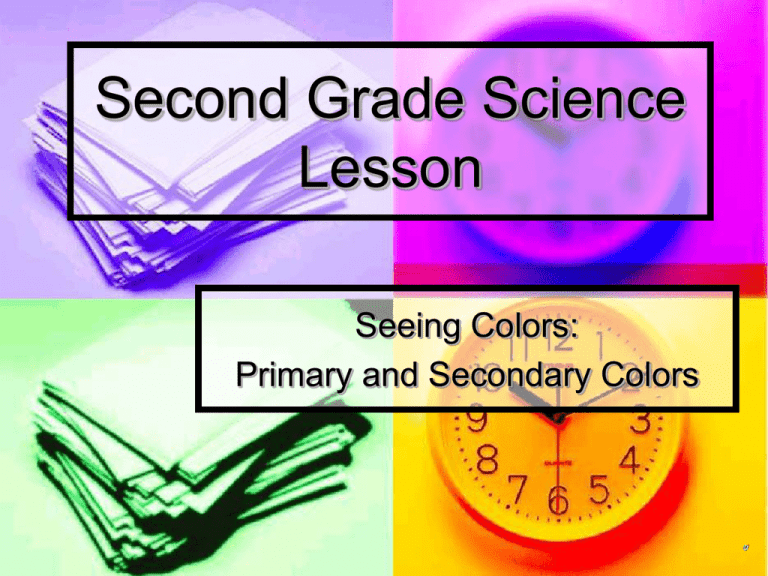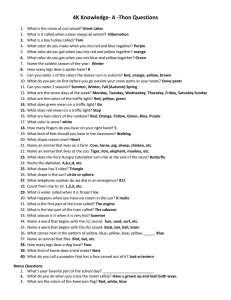PowerPoint
advertisement

Second Grade Science Lesson Seeing Colors: Primary and Secondary Colors Objectives Cognitive: In a classroom setting each student will be able to: List sight as one of the five senses. State that our eyes are used for sight. OBJECTIVES CONT. Psychomotor: Each student will be able to: Determine the color of an object. Identify the primary colors (red, blue, yellow. Identify the secondary colors (purple, orange, green). Objectives Cont. 2 Affective: The Students will be able to : Describe how they felt when they had the opportunity to mix primary colors in order to get secondary colors. MATERIALS REQUIRED Attribute Blocks Colorful Objects of Different shapes. Finger Paints Food Coloring 4 Clear plastic cups Overhead Projector Materials Required Continued Copy of Primary and Secondary Venn Diagram. Copy of Primary and Secondary color assessment page. Teaching Methods Use of the overhead Brainstorming Venn Diagram Demonstrations Listening Writing Class/Lab work Information Sheets Question and Answer Other Discovery Display Small Groups Whole group Diagramming Problem Solving Illustrated Talks Investigation Color Wheel Using Primary Colors to get Secondary colors INTRODUCTION The purpose is to engage my students in the art process of color. Let the students know what is going to be expected of them during the lesson. Positive reinforcement designed to motivate the students. Engage 1. I will use the overhead projector to display several attribute blocks of the same size and shape, but of a different color. 2. I will hold up a red and blue square and have the students describe the two attribute blocks. The teacher will say: Describe the attributes of these objects. 3. The teacher will ask the students: What did you use to determine the attributes? (My eyes) then the teacher would ask : How are they alike? (shape and size) Then I would ask? 6 CONTENT EXPLORE: 1. The teacher will distribute objects (blocks, toys, etc.) that vary in color to the students. 2. The students will make a list of attributes for each object. 3. The teacher will have the students mix finger paints to make different colors. Explain 1. The teacher will show the students red, blue, and yellow objects. Then the teacher will ask: What color are these objects? (red, blue, and yellow) I will then explain that these three colors are called primary colors. 2. I will then place red, blue, and yellow on the Venn Diagram for the students to observe. EXPLAIN CONTINUED 3. The teacher will place the four plastic cups on the overhead projector. The teacher will then pour water colored with red food coloring into one cup. Then the teacher will have the students predict what will happen when the teacher pours yellow water into the red water. The teacher will then write the students predictions on the board. The teacher then pours the yellow water into the cup with red water and then asks the students what happened when I added the yellow water? (The students should respond The water turned orange.) Explain Cont 2 4. The teacher leaves the orange cup, and then puts the blue cup and another yellow cup on the overhead and asks the students to predict what will happen when I mix these two cups. (the students should answer the color will be green) The teacher then asked the students what do you think will happen if I mix red and blue together? They should answer (you get purple) I then asked the students what will happen if I mix red, blue and yellow together in the same cup. (You get Black) EXPLAIN CONT. 3 5. I THEN POINTED OUT THE THREE PRIMARY COLORS AND THE THREE SECONDARY COLORS. 6. I ASKED THE STUDENTS: What colors make orange, green, and purple. Their answer should be (red+yellow=orange, blue+yellow=green, and blue+red=purple) what color is formed in the middle? (black or brown, depending upon the mix and the paint. 7. Summary Elaborate: The way that the teacher intends on wrapping up this lesson would be to give the students the opportunity to mix their own secondary colors using primary colors. The teacher gives each student their own Venn Diagram worksheet to experiment mixing colors in order to get secondary colors. 8. Evaluation 1. The teacher will listen to the students to determine whether they understand the proper vocabulary such as primary, and secondary. 2. The teacher will observe the students to determine if they can mix two primary colors to get each secondary color. 3. The teacher will place two paint colors on paper and have the students predict the color mix. 4. The teacher will give each student an informal assessment worksheet to assess whether they can answer the questions given on primary and secondary colors.





